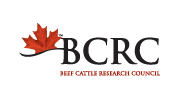Predicting feed efficiency more economically
| Project Code: | FDE.06.09 |
| Completed: | March 2013 |
Project Title:
Biological Predictors of Feed Efficiency in Feedlot Cattle
Researchers:
Dr. Stephen P. Miller miller@uoguelph.ca
Dr. Yuri Montanholi, Dr. Kendall Swanson, Dr. Brian McBride
Background: Feed efficiency is of tremendous economic importance but is difficult, time consuming and expensive to measure. This has limited the beef industry’s ability to improve feed efficiency. Identifying biological measurements that can be accurately predict feed efficiency would be very valuable if they could be collected more easily, and quickly and economically than actual feed intake.
Objective: To identify whether infrared thermography measurements, specific hormone or metabolite levels, or feeding behaviors can reliably predict feed efficiency.
What they did: Researchers collected infrared thermography measurements of body heat production and monitored hormone and enzyme levels in the blood and feces, observed feeding behavior, evaluated histology, blood plasma, colostrum, and milk quality, bull fertility, and methane production in individual groups of steers, heifers, cows, and bulls that were previously tested for feed efficiency using residual feed intake (RFI). Researchers then analyzed all the data to determine if any of these traits were known to corelate with feed efficiency.
What they found: Researchers found that highly efficient cattle had:
- lower methane emissions
- higher fecal cortisol metabolites
- lower feed intake
- decreased eating rate
- decreased visits to the feeder
- lower age at sexual maturity (heifers)
- lower age at conception (heifers)
- more metabolically active small intestine
- increased milk lactose content
- improved colostrum quality
- lower semen quality
Other factors measured showed no correlation with efficiency.
What it means: This is the first step in developing an economical, rapid and easy way to predict feed efficiency and having such a test would be a valuable addition to genetic improvement programs. From here further research needs to be done into how to quickly and efficiently test for the most promising traits that were found to be associated with feed efficiency.








